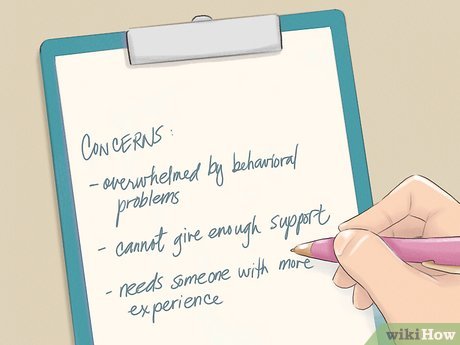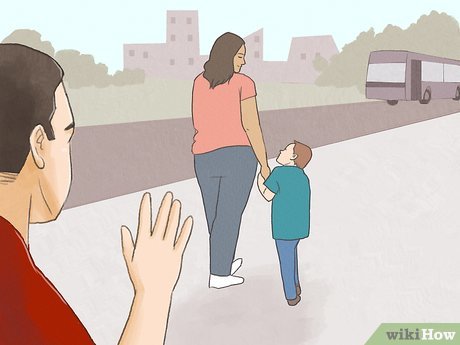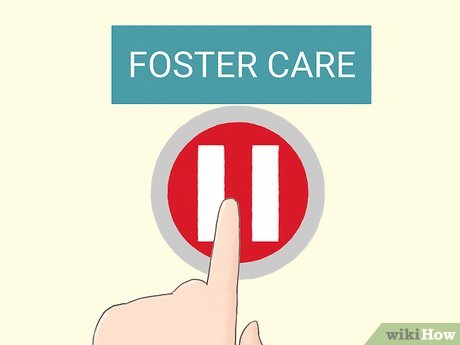Fostering children is a great way to provide some stability in a child’s life. However, there may come a time when you and your foster child just aren’t meshing well together (or, they might be a danger to you and your family). There’s no shame in asking for a foster child to be removed, especially if you’ve already tried multiple ways to manage their behavior. If you’d like to have a foster child removed from your home, read through the ways you can get the process started right away.
StepsMethod 1Method 1 of 2:Non-Emergency Removal
1Contact your supervising social worker. They’re the ones who will be able to facilitate your foster child’s removal. Call or text them on the number they gave you and explain that you’d like to talk about removing the child from your home. If it’s not an emergency, you don’t have to give any details until you two meet in person, so don’t worry about explaining your reasoning until later.XYou might ask that a child be removed from your home if they have needs that you can’t meet or behavioral issues you aren’t equipped to deal with.If it is an emergency, tell your social worker that you need to meet with them that same day instead of waiting.
2Meet with your social worker and list your concerns. For a non-emergency removal (meaning that no one’s life is in danger), your social worker will meet with you in person within the next 5 days. When you two talk, you can list your concerns about your foster child and why you want to have them removed from your home.XTry to be as specific as you possibly can, and list the things that you’ve already tried.For instance, you might say, “Their behavioral problems are just too much for me to handle, and I don’t think I can give them the support they need. I feel like they might do better in a different home with someone who is more experienced.”
3Talk with your social worker and your foster child. If your foster child is old enough, your social worker will want to talk to them. Older foster children have a say in where they live, so your social worker might want to hear from them, too. You can sit down with both of them to chat about why you feel they might do better in a different home. This can be difficult to talk about—if you don’t feel comfortable chatting with your foster child in the room, ask to speak to your social worker separately.XYou might want to sit down with your foster child ahead of time and explain why you’re asking for them to be removed. If they’re old enough, they might understand that it’s for the best, and it can help prepare them when the social worker comes to visit.If your foster child also wants to be moved to a different home, there’s a much higher chance that they’ll actually get removed. However, if they like living with you, your social worker might try implementing a plan to work out your problems.
4Try to work out any issues before a removal. Moving from home to home can be tough on a foster child, especially if they haven’t had much stability in the past. If your social worker thinks that you two just need some time to adjust, they may recommend that your foster child stays in your home for the time being. That way, you two have more time to get used to each other and they can work on fitting into your home.XSocial workers are usually pretty hesitant to remove a child from the home if they can avoid it. They might suggest ways you can manage behavior or get extra support if you need it.
5Request a removal from your social worker. If you and your social worker can’t figure out a way for your foster child to stay in your home, you can ask them to take the child. Most likely, the foster child will go to a new home, and you’ll be asked if you’d like to foster another child or take a break for a little while.XIf you had to have a child removed from your home, it might be beneficial for you (and your family) to put a pause on fostering, at least for a little bit. It will give you a chance to take a step back and think about if fostering is right for you.X There’s no shame in taking a break, and it can help prevent getting burnt out or overwhelmed.Method 2Method 2 of 2:Emergency Removal
1Request an emergency removal in dangerous situations. If you feel like you or anyone else’s life is in danger (including the foster child’s), you can get them removed from your home immediately. You can also request an emergency removal if you feel like you can’t take care of the foster child or you think there may be sexual activity between your foster child and your biological children.XYou might request an emergency removal if the foster child has threatened you or a family member, has made sexual advances upon your children, or has threatened themselves in any way.
2Contact your supervisory case worker. Let them know that you’re requesting an emergency removal, and tell them a few details over the phone. Since these situations can be dangerous, you want them to understand the gravity of the situation and come out to see you right away.XIf you or your family feel unsafe, contact emergency services as well.
3Meet with them that same day and list your concerns. For emergency removals, social workers are required to meet with you the very same day. Tell them about all of your concerns and list the reasons why you think that your foster child should be removed from your home. If the social worker agrees, they can take the child right away.XGive as many details as you can, and be as specific as possible. Most social workers will hesitate to remove a child from the home unless they know that someone is in danger.
4Take a break after an emergency removal to regroup. Getting a foster child removed from your home is stressful, especially an emergency removal. Once your foster child has been removed, it might be good for you and your family members to put fostering on pause for a little while. You can always contact your social worker when you’re ready to try again.XIf you realize that fostering isn’t for you, that’s okay! You can always serve children in another way, like becoming a mentor, becoming a tutor, or joining a Big Brother/Big Sister program.








